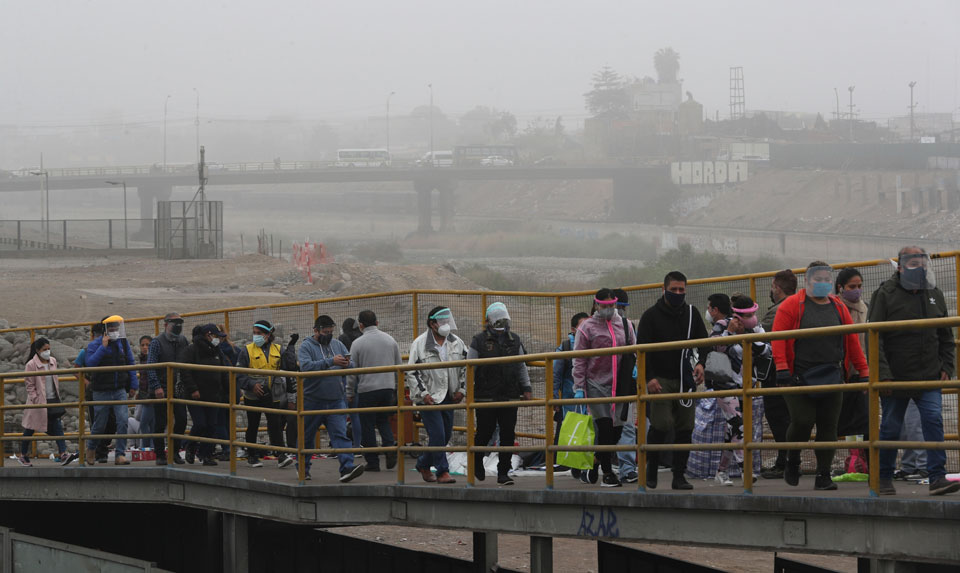
On March 11, Peru declared a 90-day national sanitary emergency to deal with the emerging coronavirus crisis. Subsequently, the country announced a total lockdown beginning from March 16. But despite implementing one of the earliest and strictest COVID-19 containment regimes in Latin America, Peru has become trapped in the turmoil of rising COVID-19 cases. With more than 400,000 cases, Peru has become the third-worst hit country in Latin America. It also has one of the highest excess death rates (count of deaths relative to a normal year)—87% more than a normal year for the period from March 16 and May 31.
The current COVID-19 catastrophe in Peru is a natural corollary of the unbridled process of capitalist consolidation and control which defines the country’s health care system. As a result of this aggressive accumulation of capital, the health sector in today’s Peru is teetering on the edge of an abyss. In this country, “public health facilities for molecular testing are sparse and only 500 beds in intensive care units exist for a population of 32 million.” Further, private hospitals are charging $3,000 per day for coronavirus care, a price which is absurd considering 1 out of every 5 Peruvian is impoverished, earning less than $105 per month. Discontented with and devastated by the massive deficiencies of public hospitals and the avarice of the private sector, Peruvians have taken to the streets to demonstrate against these patent injustices.
In the southern city of Arequipa, people protested against Peru’s President Martín Vizcarra, who had come to visit the Honorio Delgado Hospital. It was during these protests that Celia Capira ran after the president’s motorcade, desperately shouting, “Mr. President, don’t go!” Capira’s 57-year-old husband, Adolfo Mamani, was kept in a bedraggled tent outside the Honorio Delgado Hospital, where he died on July 21. While running behind the president’s vehicle, Capira said, “Mr. President, you have to go to the tent, don’t leave the hospital until you’ve seen the condition [patients] are in.”
The dizzying scale and sheer grimness of coronavirus deaths in Peru is not an isolated and sporadic event. In the city of Iquitos, too, “many people are dying and patients are forced to be seated outside the hospital in rocking chairs or in makeshift hospitals on football fields.” The numbers of deaths are so enormous that Venezuelan immigrants are being employed to collect the carcasses of COVID-19 victims. These immiserated immigrants collect dead bodies “from poor neighborhoods, from homes where people can’t afford to hire a funeral director to handle the burial.”
Corporate priorities over patient outcomes
The current health crisis in Peru is deeply anchored in the neoliberal reforms which were introduced by successive governments beginning from the 1990s. Through these neoliberal policies, the U.S.-imported model of “managed competition” was installed. The core idea of this health arrangement was to install a privately managed corporate framework which would operate simultaneously with public hospitals. But these private hospitals would not prosper if public hospitals continued to offer good services at a low cost. Therefore, the problem framed by neoclassical economists was this: “If people can obtain health care for free or at a uniformly low cost, they will not have much incentive to pay insurance premiums to cover unexpected health hazards.”
In order to make private hospitals prosper, the public health sector had to be sapped because no one would want to visit profit-minded private hospital over good quality public hospitals. This was done through a reduction in social spending, which decreased to 9.4% of GDP in 2012, far below the Latin American average of 19%. There were two direct results of this undercutting of public health sector.
First, due to shriveling resources, urban health services sharply separated into an organized social security system for formally employed urban workers and a disorganized, defunded public health system for the poor. In this arrangement, the “social security health system offered urban formal sector workers a ‘sanitized’ health system of higher quality and better resources than the public health system that served the poor.” When it comes to patient safety, for example, it has been found that richer patients (enrolled in the urban security health system) receive better attention than poorer patients (visiting public hospitals).
This is a frightening defect in the Peruvian health sector considering the fact that the public hospitals serve 73.8% of the population. In spite of being the primary health facility for the entire country, public hospitals have not improved, and this has led to low-income patients seeking the services of local pharmacies. According to World Health Organization, “in reality most public hospitals are so under-funded or payment procedures by AUS [Universal Health Insurance] are so lengthy and bureaucratic that many patients eventually buy their own medicines, facing significant out-of pocket expenditures.” In some cases, these out-of-pocket health expenditures have become “catastrophic health expenditures,” i.e., healthcare spending equal to or higher than 40% of the household’s capacity to pay.
Catastrophic health expenditure is frequently the norm in Peru because the country’s government gives enormous tariff exemptions to multinational corporations and thereby loses revenue which could have been used to fund public health services and provide free medicines to the populace. But an end to the predatory practices of multinational corporations has not happened in Peru, and medicinal prices are continuing to rise.
In 2014, for example, “the cost of the antiretroviral drug atazanavir (Reyataz) was eating up fully half of Peru’s budget for AIDS medicines. Peru was paying $10.50 per pill, while the same pill cost $3.60 in Brazil and as little as 50 cents on the international market… To look at it another way, a year’s treatment was costing Peru $3,832 per patient, while the Pan American Health Organization’s Strategic Fund was obtaining generics for only $182 per patient.”
In the current conditions of the COVID-19 pandemic, Peru’s health situation has drastically worsened due to the systematic defunding of public hospitals and the population’s consequent heavy reliance on out-of-pocket health expenditures. According to the Volume 1 of “Financing Health in Latin America,” in times of health shocks, “poor and uninsured households will need to drastically adjust their current consumption to afford large OOP [out-of-pocket] health expenditures. Furthermore, these temporary adjustments may have permanent consequences. If food expenditures are reduced, children’s nutrition may suffer, with possibly permanent effects on their learning abilities, thus affecting their future performance at school and in the labor market. Children may also be forced to drop out of school…if the health shock lasts long enough. In any event, either catastrophic health expenditures or income losses may push the family of a severely ill or injured person into poverty.” It is pertinent to note that out-of-pocket or catastrophic payment indicators understate the gravity of the problem since “there are people who do not utilize health services when needed because they are unable to afford out-of-pocket payments at all.”
Leaving the countryside behind
Secondly, as a result of the gradual weakening and privatization of public hospitals, the rural regions have been effaced from the socio-medical imaginary. With the erosion of public health services to an extent that it barely sufficed for the urban population, the frayed rural edges of Peru started receiving what was left of an outstretched public health sector. It is estimated that “90 percent of public hospitals and health clinics are in urban areas, 7 percent in marginal urban zones and only 3 percent in rural areas. In 2009, Lima concentrated 53 percent of the country’s physicians, 40 percent of its nurses and 44 percent of the deontologists.” In these urban areas, there are select private hospitals which “offer acceptable care covering a wide range of specialties, with many doctors trained in Europe and the U.S.”
While European and American doctors cater to the need of rich patients in urban areas, rural patients in Peru receive medical care which is gruelingly inadequate. In the rural areas, there are four main problems:
- “Lack of tools to address challenging types of diagnostic problems,
- health system-related barriers to the diagnostic process,
- patients’ barriers in following through with diagnostic referrals, and
- ideas for technological innovation to enhance the diagnostic process.”
Apart from these four problems directly related to the defunding of public health system, another issue has been doctors’ unwillingness to work in public hospitals.
According to an OECD (Organization for Economic Cooperation and Development) study, “even though health professionals are trained in both public and private universities, the majority do not end up working for public health providers and even less in rural and marginal areas.” To remedy this, the Rural and Urban Marginal Health Service (SERUMS) was implemented wherein it was made mandatory for health professionals to work in rural or peri-urban areas for normally one year. One year after the completion of SERUMS, “it has been shown that only 25% of health professionals were working in the public sector, evidencing more attractive working conditions elsewhere. Moreover, only 10% of specialists were working in the public sector two years after completing their residencies.”
SERUMS has proved to be fruitless because as long as a profit-maximizing logic exists in the health sector, doctors too will choose an occupation which guarantees the greatest returns on their skills. A generalized framework of capital self-valorization in which surplus accumulation is an end in itself, the medical sector gets economically embroiled in the unending circuit of capital and is repatterned as a profession concerned with profiting from patients. In Peru, SERUMS was not able to reconstruct the highly unequal urban-rural medical divide because capital-centered health practices remained untouched and unaffected by piecemeal health initiatives.
Where patients come before profits
Peru’s inherently unequal health system differs strikingly from the socialist medical administration which is established in Cuba. A study by the Tricontinental Institute for Social Research documents how “Cuba’s revolutionary system has given it the strength and ability to survive in the face of blockades and pandemics, integrating workers, peasants, scientists, mass organisations, and civil defence systems with a party and a government that puts human life at the centre of its attention.”
With a socialist health system wherein profit motives are secondary to collective ethics, Cuba trains doctors to prioritize cooperative feelings over individualistic sentiments. Using Lenin’s words, one can say that in Cuba, “The majority [of the doctors] are of the kind who are willing to struggle to solve the fundamental problem of the salvation of our culture, and these doctors are devoting themselves to this hard and difficult task with as much self-sacrifice as a military specialist. They are prepared to give their strength to the promotion of the common cause.”
As the COVID-19 pandemic progresses in Peru, the immense inequalities of the entire health system are being laid bare. Through neoliberal policies, public hospitals have been destabilized, exposing innumerable Peruvians to the vagaries of the COVID-19 health shock. The magnitude of those people left unprotected from the pandemic in Peru has increased in the last few months due to urban job losses in the formal sector. By analyzing the electronic payroll, a major indicator of formal employment, we know that during the COVID-19 pandemic, informalization has increased. When “this indicator is compared with the same period in 2019 it emerges that the figure fell nearly 30 percent in March 2020 (the lockdown was imposed on March 16) and nearly 80 percent in April and May.”
Now, more people are living outside the social security system, totally dependent on out-of-pocket expenditure and a disintegrating public health system. In the current period, it is even clearer that a capitalist for-profit medical system makes life worse for millions and sacrifices them for profit. It has to be replaced by a health system where profits are removed from the equation and patients’ health and lives are what count.










